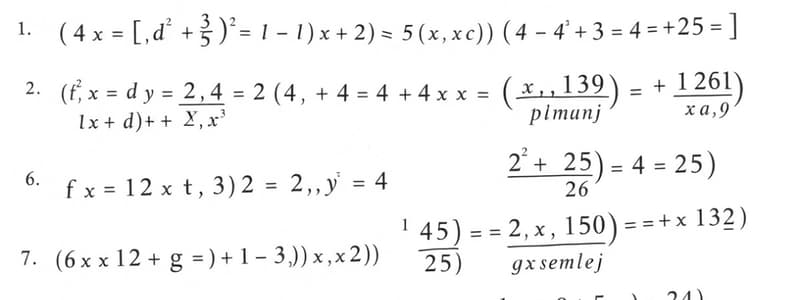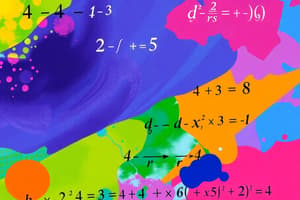Podcast
Questions and Answers
What does the term 'variable' refer to in algebra?
What does the term 'variable' refer to in algebra?
- An equation that uses letters and numbers
- A symbol representing an unknown value (correct)
- A fixed numerical value
- A statement that two expressions are equal
What is an algebraic expression?
What is an algebraic expression?
- A fixed value in a mathematical problem
- An equation where both sides are equal
- A combination of variables, constants, and operators (correct)
- The process of solving for x
Which operation is used to combine like terms in algebra?
Which operation is used to combine like terms in algebra?
- Subtraction
- Multiplication
- Addition (correct)
- Division
Which of the following is an example of a linear equation?
Which of the following is an example of a linear equation?
What must be performed to isolate a variable in an equation?
What must be performed to isolate a variable in an equation?
How do you perform the distributive operation?
How do you perform the distributive operation?
What does it mean to factor a quadratic expression?
What does it mean to factor a quadratic expression?
Which of these options correctly describes an inequality?
Which of these options correctly describes an inequality?
Flashcards are hidden until you start studying
Study Notes
Basic Concepts
- Definition: Algebra is a branch of mathematics that uses symbols (usually letters) to represent numbers in equations and formulas.
- Variables: Symbols (often x, y, z) that represent unknown values.
- Constants: Fixed values that do not change.
Expressions and Equations
- Algebraic Expression: A combination of variables, constants, and operators (e.g., 2x + 3).
- Equation: A statement that two expressions are equal (e.g., 2x + 3 = 7).
Operations
- Addition: Combining like terms (e.g., 2x + 3x = 5x).
- Subtraction: Taking away like terms (e.g., 5x - 2x = 3x).
- Multiplication: Distributing (e.g., a(b + c) = ab + ac).
- Division: Splitting terms (e.g., 10x / 2 = 5x).
Solving Equations
- Isolate the variable: Move all terms involving the variable to one side and constants to the other.
- Perform inverse operations: Use addition/subtraction or multiplication/division to simplify.
- Check solutions: Substitute back into the original equation to verify.
Types of Equations
- Linear Equations: First-degree equations (e.g., y = mx + b).
- Quadratic Equations: Second-degree equations (e.g., ax² + bx + c = 0).
- Polynomial Equations: Equations involving variables raised to various powers.
Functions
- Definition: A relationship between a set of inputs and outputs, where each input has a single output.
- Notation: f(x) represents a function of x.
Key Principles
- Distributive Property: a(b + c) = ab + ac.
- Commutative Property: a + b = b + a and ab = ba.
- Associative Property: (a + b) + c = a + (b + c) and (ab)c = a(bc).
Factoring
- Greatest Common Factor (GCF): The largest factor shared by terms.
- Factoring Quadratics: Writing ax² + bx + c as (px + q)(rx + s).
Inequalities
- Definition: Mathematical expressions indicating one value is less than, greater than, etc. (e.g., x < 5).
- Solving Inequalities: Similar to equations; however, flipping the inequality sign when multiplying or dividing by a negative number.
Graphing
- Coordinate Plane: A two-dimensional surface on which points are plotted.
- Linear Graphs: Straight lines representing linear equations; the slope indicates the steepness.
Applications
- Problem Solving: Use algebra to model and solve real-world problems.
- Patterns and Relationships: Identify and express relationships between quantities.
Basic Concepts
- Algebra employs symbols to represent numbers within equations and formulas.
- Variables (e.g., x, y, z) represent unknown values, while constants are fixed values that remain unchanged.
Expressions and Equations
- An algebraic expression consists of variables, constants, and operators, such as in 2x + 3.
- An equation asserts that two expressions are equivalent, for example, 2x + 3 = 7.
Operations
- Addition combines like terms, illustrated by 2x + 3x resulting in 5x.
- Subtraction involves removing like terms, e.g., 5x - 2x yields 3x.
- Multiplication distributes, demonstrated as a(b + c) = ab + ac.
- Division separates terms; for instance, 10x divided by 2 results in 5x.
Solving Equations
- The goal is to isolate the variable by moving variable terms to one side of the equation and constants to the other.
- Inverse operations, such as addition/subtraction or multiplication/division, simplify expressions.
- Check solutions by substituting values back into the original equation to confirm accuracy.
Types of Equations
- Linear equations are first-degree equations, commonly expressed as y = mx + b.
- Quadratic equations are second-degree forms represented by ax² + bx + c = 0.
- Polynomial equations include variables raised to various exponents.
Functions
- A function establishes a relationship between inputs and outputs, ensuring each input corresponds to a unique output.
- Function notation is denoted as f(x), indicating a function of x.
Key Principles
- The Distributive Property states that a(b + c) equals ab + ac.
- The Commutative Property allows for rearranging terms: a + b = b + a and ab = ba.
- The Associative Property shows that the grouping of terms does not affect the outcome: (a + b) + c = a + (b + c) and (ab)c = a(bc).
Factoring
- The Greatest Common Factor (GCF) is the largest shared factor among terms.
- Factoring quadratics involves rewriting ax² + bx + c in the form of (px + q)(rx + s).
Inequalities
- Inequalities express relationships where one value is less than or greater than another, such as x < 5.
- To solve inequalities, follow similar strategies as equations, but flip the inequality sign when multiplying or dividing by a negative.
Graphing
- A coordinate plane is a two-dimensional surface, where points are represented by pairs of numerical coordinates.
- Linear graphs depict straight lines corresponding to linear equations; slope indicates the line's steepness.
Applications
- Algebra facilitates problem-solving by modeling and addressing real-world scenarios.
- Identifying patterns and relationships between quantities is a crucial application of algebraic concepts.
Studying That Suits You
Use AI to generate personalized quizzes and flashcards to suit your learning preferences.




